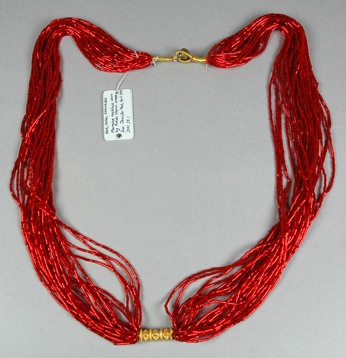Marriage necklace
Nepal, 2001
 Collected and donated by Jenny Peck in 2001; 2001.28.1This heavy necklace is called a potey tilhari and is traditionally worn by Nepali women as a sign of married status. It fulfils the same function as a ring in the Western world.
Collected and donated by Jenny Peck in 2001; 2001.28.1This heavy necklace is called a potey tilhari and is traditionally worn by Nepali women as a sign of married status. It fulfils the same function as a ring in the Western world.
Before a couple are married the father of the groom purchases a hollow cylinder bead of 18–24 carat gold (tilhari) and takes it to a bead seller who makes the necklace. The traditional colours for the glass beads (potey) are either vermillion red or bright green. Red is the most common colour since both red and pink are associated with good luck and fertility. For this reason the bride may wear a pink sari at the wedding ceremony. After the and groom are announced married, the groom places the necklace around the neck of his bride as a gift from his family, symbolizing the wish and prayer for long life.
Nepali women traditionally wear silver and gold jewellery, including bracelets, large earrings, and a nose ring. Up until the age of around fifteen, young Nepali men also wear silver bracelets and plain gold earrings. After the wedding, married women may also choose to wear red powder (sîdur) and red bead tassels (dhaago) in their hair as a symbol of their new status. They may also wear the tilhari with different coloured glass bead necklaces to coordinate with different clothing. If a woman is widowed or divorced she is no longer entitled to wear the necklace.
